See Your Web site Load By way of Your Customer’s Eyes
Get a good suggestion of what your guests are literally experiencing after they go to your web site.
Discover something loading slowly or misplaced? This will help you establish vital lags and conversion points that your guests expertise.
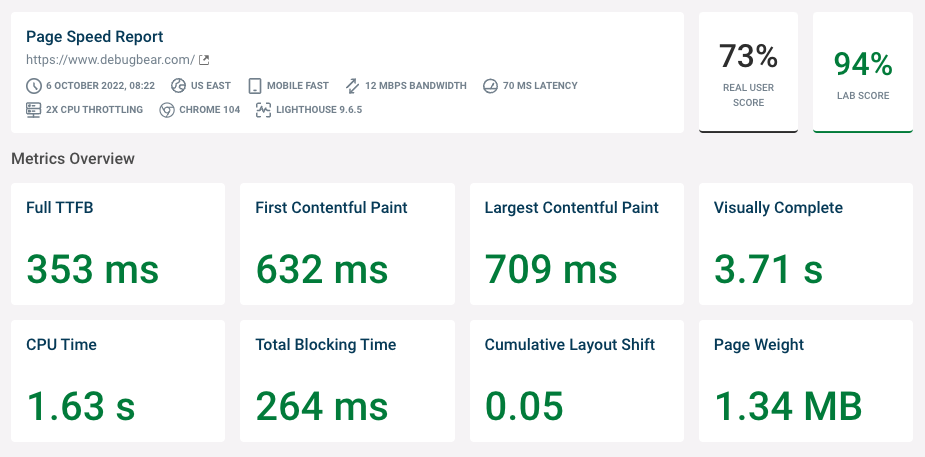 Screenshot exhibiting the results of a DebugBear net efficiency take a look at, October 2022
Screenshot exhibiting the results of a DebugBear net efficiency take a look at, October 2022The timeline filmstrip reveals the rendering progress of the web site over time.
For instance, this web page begins to render after 0.7 seconds, and the primary picture renders after 1.3 seconds.
The web site is totally rendered, also referred to as Visually Full, when the chat widget is displayed after 3.7 seconds.
 Screenshot of DebugBear exhibiting the rendering progress of a web site over time, October 2022
Screenshot of DebugBear exhibiting the rendering progress of a web site over time, October 2022Inside the instrument, you may as well watch a video recording of the rendering course of.
It is a nice approach to show the impression of efficiency points to shoppers or different members of your group.
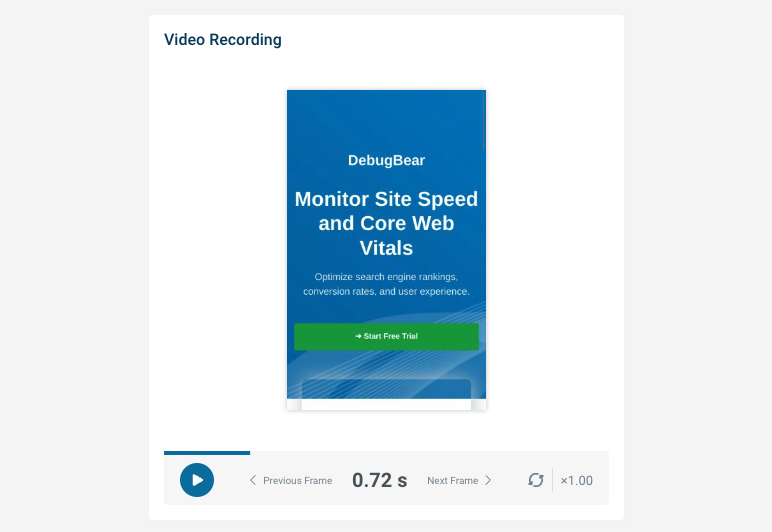 Screenshot exhibiting a video recording of {a partially} rendered web site in DebugBear, October 2022
Screenshot exhibiting a video recording of {a partially} rendered web site in DebugBear, October 2022Take a look at Web site Pace Modifications By Seeing Your True Loading Stats
Let’s say you’ve been optimizing your web site, and also you need to perceive if these adjustments will make an impression.
This instrument runs a “lab take a look at” in an optimum setting to find when you’re optimizing your web site accurately.
If you take a look at your web site, you’ll get an official “Lab Rating”, which is a abstract of six efficiency metrics that come from the Efficiency rating from Google’s Lighthouse instrument:
- First Contentful Paint (10% of the general rating).
- Pace Index (10%).
- Largest Contentful Paint (25%).
- Time to Interactive (10%).
- Complete Blocking Time (30%).
- Cumulative Format Shift (15%).
Utilizing this information, you’ll uncover how useful your final spherical of optimizations was and what it’s possible you’ll want to alter.
By now, you’re in all probability questioning what that you must change. Let’s learn to optimize your web site utilizing every key metric of the Metrics Overview.
How To Optimize Web site Pace
Working a pace take a look at is the primary a part of your web site optimization journey.
Upon getting your metrics, you’ll must know the way to interpret them and what to do to repair them.
Within the Metrics Overview space of your web site pace report, you’ll see the important thing metrics we’ll concentrate on to assist pace up your web site:
- First Contentful Paint: This may be sped up by repairing server communication pace.
- Largest Contentful Paint: This may be sped up by optimizing media and sources.
Moreover, you should utilize the request waterfall to see how lengthy requests take and the way that impacts these metrics.
How To Pace Up First Contentful Paint (FCP)
Let’s begin by making your web site present up sooner on your guests; we’ll deal with First Contentful Paint, first.
What Is First Contentful Paint?
First Contentful Paint measures how quickly a web page’s content material first begins to seem after your customer navigates to that web page.
It’s vital that your key content material reveals up rapidly to be able to maintain your customer from leaving your web site. The quicker a consumer leaves your web site, the quicker Google learns that the web page expertise could also be dangerous.
However how have you learnt precisely what’s inflicting your web site to load slowly?
How do you uncover which server points are slowing down your web site? Let’s discover out.
Why Is My First Contentful Paint Taking So Lengthy?
Your FCP could also be impacted by server connection pace, server requests, render-blocking sources, and extra.
It feels like rather a lot, however there’s a simple approach to see precisely what’s slowing down your FCP – the request waterfall.
This great tool reveals what requests are made by your web site and when every request begins and finishes.
For instance, on this screenshot, we first see a request for the HTML doc after which two requests to load stylesheets which are referenced within the doc.
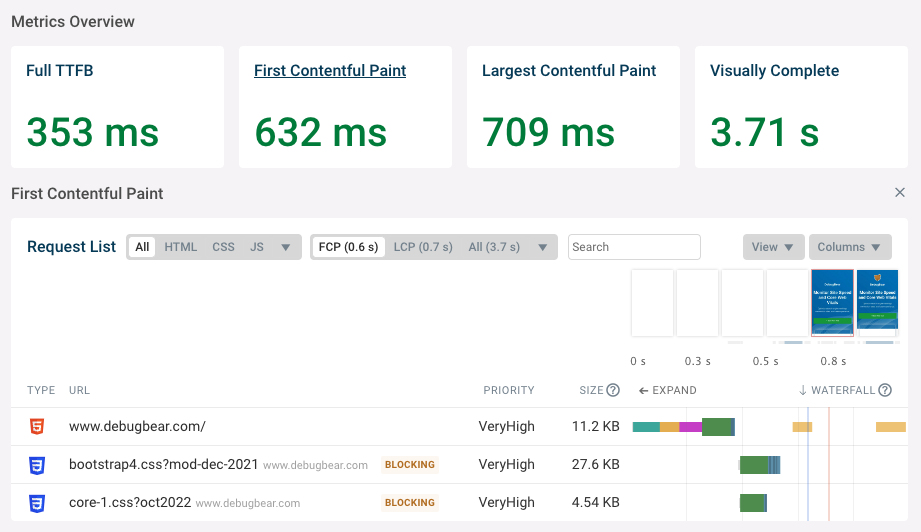 Screenshot exhibiting debug information for the First Contentful Paint metric in DebugBear, October 2022
Screenshot exhibiting debug information for the First Contentful Paint metric in DebugBear, October 2022Why does the First Contentful Paint occur after 0.6 seconds? We will break down what’s taking place on the web page to grasp this.
Understanding What Occurs Earlier than A First Contentful Paint
Earlier than the primary items of content material can load in your webpage, your consumer’s browser has to first connect with your server and retrieve the content material.
If this course of takes a very long time, then it takes a very long time on your consumer to see your web site.
Your aim is to be taught what’s happening earlier than your web site begins to load so you’ll be able to pinpoint points and pace up the expertise.
Web page Load Half 1: The Browser Creates A Server Connection
Earlier than first requesting a web site from a server, your customer’s browser wants to ascertain a community connection to that server.
This sometimes takes three steps:
- Checking DNS data to search for the IP deal with of the server based mostly on the area title.
- Establishing a dependable server connection (often known as a TCP connection).
- Establishing a safe server connection (often known as an SSL connection).
These three steps are carried out by the browser, one after the opposite. Every step requires a spherical journey out of your customer’s browser to your web site’s server.
On this case, it takes round 251 milliseconds to ascertain the server connection.
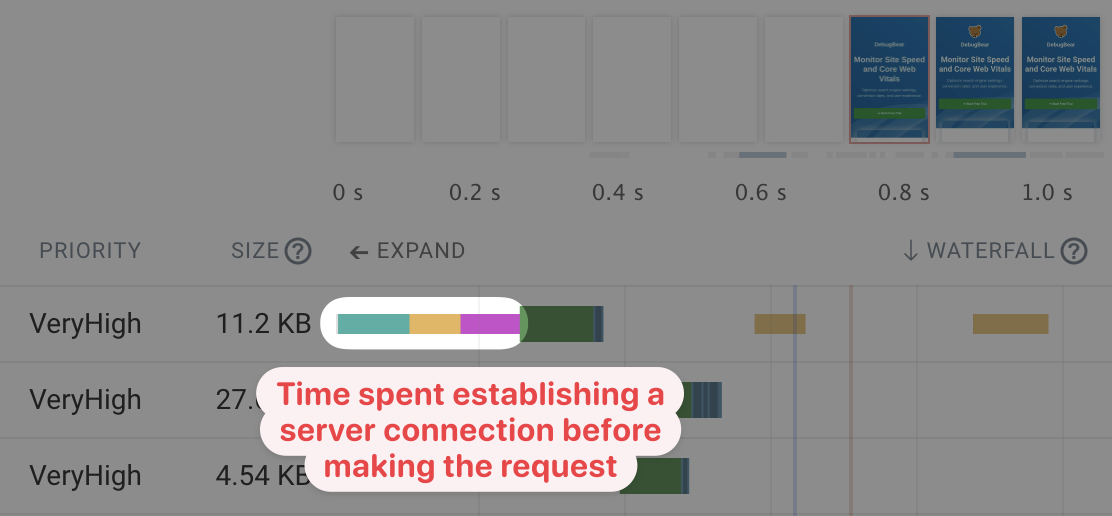 DebugBear screenshot exhibiting the community spherical journeys used to ascertain a server connection, October 2022
DebugBear screenshot exhibiting the community spherical journeys used to ascertain a server connection, October 2022Web page Load Half 2: The Browser Requests The HTML Doc (Time To First Byte Occurs Right here)
As soon as the server connection is established, your customer’s browser can request the HTML code that incorporates the content material of your web site. That is referred to as an HTTP request.
On this case, the HTTP request takes 102 milliseconds. This period contains each time spent on the community spherical journey and the time spent ready for the server to generate a response.
After 251 milliseconds to create the connection and 102 milliseconds to make the HTTP request, your customer’s browser can lastly begin downloading the HTML response.
This milestone known as the Time to First Byte (TTFB). On this case, that occurs after a complete of 353 milliseconds.
After the server response is prepared, your customer’s browser spends some extra time downloading the HTML code. On this case, the response is pretty small and the obtain solely takes an extra 10 milliseconds.
 DebugBear screenshot exhibiting the totally different parts of an HTTP request, October 2022
DebugBear screenshot exhibiting the totally different parts of an HTTP request, October 2022Web page Load Half 3: Your Web site Hundreds Extra Render-Blocking Assets
Browsers don’t render, or present, pages instantly after loading the doc. As an alternative, there normally are extra render-blocking resources.
Most pages would look dangerous with none visible styling, so CSS stylesheets are loaded earlier than a web page begins rendering.
Loading the two extra stylesheets on this web site pace take a look at instance takes 137 milliseconds.
Word that these requests don’t require a brand new server connection. The CSS recordsdata are loaded from the identical area as earlier than and may re-use the prevailing connection.
 DebugBear screenshot exhibiting extra render-blocking sources being loaded after the HTML doc, October 2022
DebugBear screenshot exhibiting extra render-blocking sources being loaded after the HTML doc, October 2022Web page Load Half 4: The Browser Renders The Web page
Lastly, as soon as all the mandatory sources have been loaded, your customer’s browser can begin rendering the web page. Nevertheless, doing this work additionally takes some quantity of processing time – on this case, 66 milliseconds. That is indicated by the orange CPU job marker within the waterfall view.
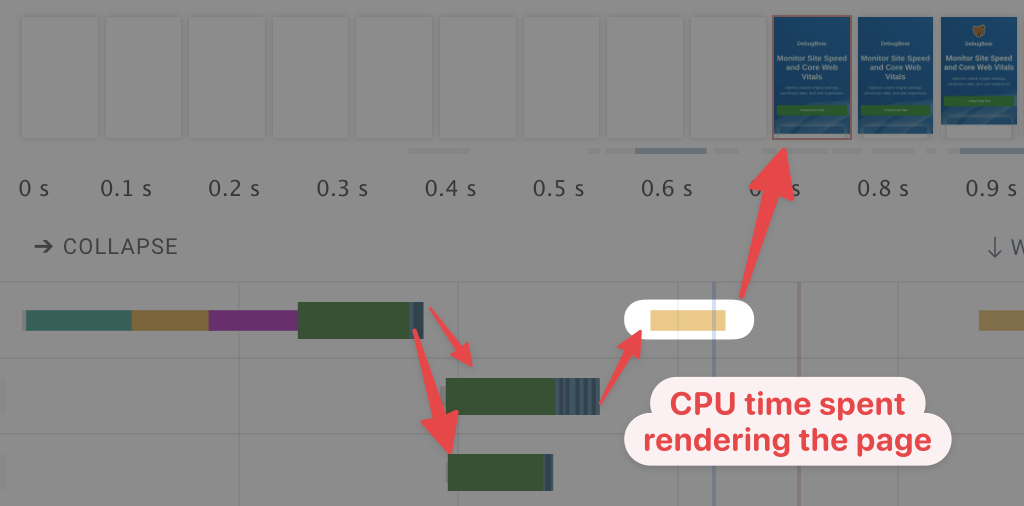 DebugBear screenshot exhibiting the steps main from loading the HTML doc to rendering the net web page, October 2022
DebugBear screenshot exhibiting the steps main from loading the HTML doc to rendering the net web page, October 2022We now perceive why the FCP occurs after 632 milliseconds:
- 364 milliseconds for the HTML Doc request.
- 137 milliseconds to load the stylesheets.
- 66 milliseconds to render the web page.
- 65 milliseconds for different processing work.
The opposite processing work contains small jobs like working inline scripts or parsing the HTML and CSS code as soon as it’s downloaded. You may see this exercise as small grey traces just below the rendering filmstrip.
How To Optimize First Contentful Paint (FCP)
Now that you simply perceive what leads as much as your web site being rendered, you’ll be able to take into consideration the way to optimize it.
- Can the server reply to the HTML request extra rapidly?
- Can sources be loaded over the identical connection as a substitute of making a brand new one?
- Are there requests that may be eliminated or modified to not block rendering?
Now that the start items of your web site are loading sooner, it’s time to concentrate on making the complete web site load quicker.
How Pace Up Largest Contentful Paint (LCP) With DebugBear’s Suggestions
There are loads of methods to hurry up your LCP.
To make it straightforward, DebugBear offers us nice subsequent steps inside their Suggestions part.
Let’s check out some examples of the suggestions and learn to pace up this web site’s LCP.
Suggestion 1: Provoke LCP Picture Requests From The HTML Doc
If the biggest content material component in your web page is a picture, the most effective follow is to make sure that the URL is straight contained within the preliminary HTML doc. This can assist it begin loading as quickly as attainable.
Nevertheless, this greatest follow just isn’t all the time used, and generally it takes a very long time earlier than the browser discovers that it must obtain the primary picture.
Within the instance beneath, the biggest content material, which is a picture, is added to the web page utilizing JavaScript. Consequently, the browser must obtain and run a 200-kilobyte script earlier than it discovers the picture and begins downloading it.
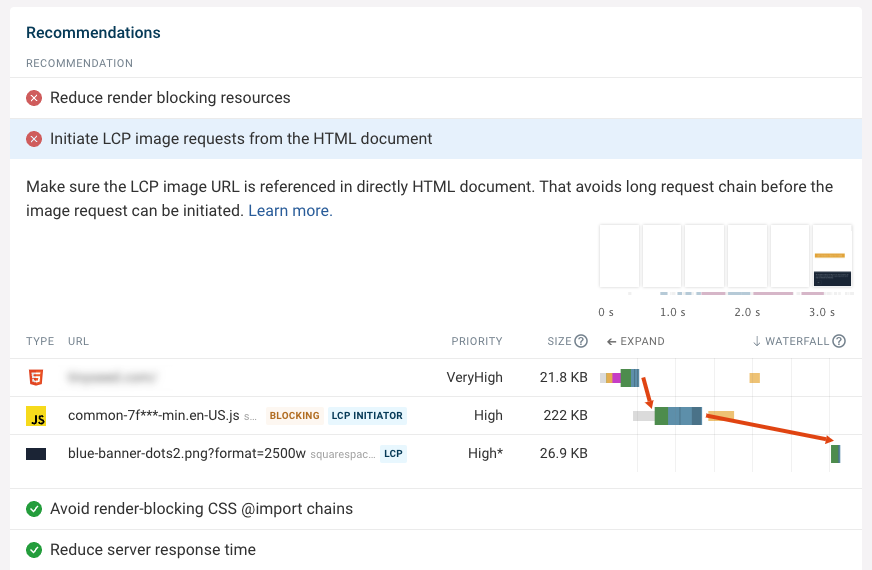 DebugBear screenshot exhibiting a sequential request chain main as much as a picture request, October 2022
DebugBear screenshot exhibiting a sequential request chain main as much as a picture request, October 2022How To Repair: Relying on the web site there are two attainable options.
Answer 1: When you’re utilizing JavaScript to lazy load a big picture, then optimize the picture measurement and eliminated the lazy loading script or substitute it with the trendy loading=”lazy” attribute, which doesn’t require JavaScript.
Answer 2: In different instances, server-side rendering would stop having to obtain the JavaScript app earlier than the web page can render. Nevertheless, this will generally be advanced to implement.
Suggestion 2: Guarantee LCP Pictures Are Loaded With Excessive Precedence
After loading the HTML code of a web page, your guests’ browsers could uncover that, along with your most important picture, numerous extra sources like stylesheets could should be loaded.
The aim right here is to ensure that your bigger, most important image hundreds to satisfy the Largest Contentful Paint requirement by Google.
Different sources, like third-party analytics scripts, aren’t as vital as your most important picture.
Moreover, most photographs referenced in your web site’s HTML might be beneath the fold as soon as the web page has been rendered. Some could also be hidden utterly in a nested header navigation.
Due to this, browsers initially set the precedence of all picture requests to Low. As soon as the web page has been rendered, the browser finds out which photographs are vital and adjustments the precedence. You may see an instance of that within the screenshot beneath, as indicated by the asterisk within the precedence column.
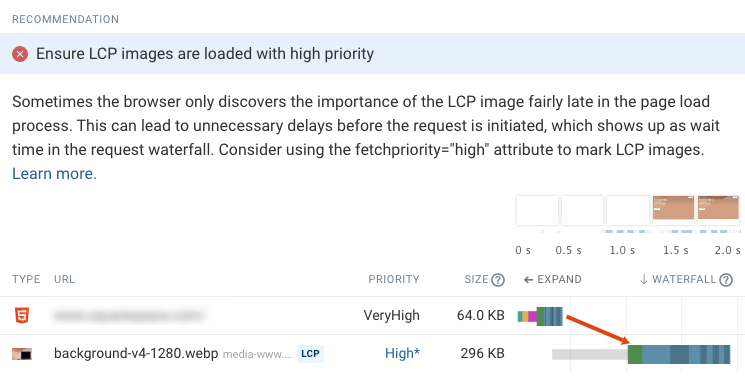 DebugBear screenshot exhibiting an LCP picture being loaded with low preliminary precedence, October 2022
DebugBear screenshot exhibiting an LCP picture being loaded with low preliminary precedence, October 2022The waterfall reveals that whereas the browser knew in regards to the picture early on, it didn’t begin downloading it, as indicated by the grey bar.
How To Repair: To resolve this you should utilize a brand new browser function referred to as precedence hints. When you add the fetchpriority=”high” attribute to an img component, the browser will begin loading the picture proper from the beginning.
Suggestion 3: Don’t Disguise Web page Content material Utilizing CSS
Typically it’s possible you’ll take a look at a request waterfall and all render-blocking sources have loaded however nonetheless, no web page content material reveals up. What’s happening?
A/B testing instruments usually hide page content till take a look at variations have been utilized to content material components on the web page. In these instances, the browser has rendered the web page however all content material is clear.
What are you able to do when you can’t take away the A/B testing instrument?
How To Repair: Test when you can configure the instrument to solely conceal content material that’s affected by A/B checks. Alternatively, you’ll be able to verify if there’s a approach to make the A/B testing instrument load extra rapidly.
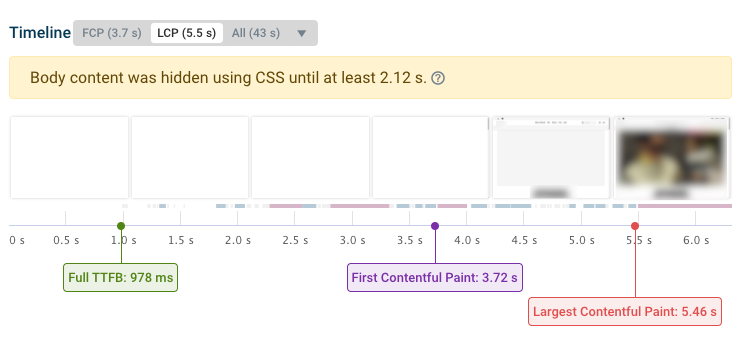 DebugBear screenshot exhibiting a rendering filmstrip the place content material is hidden by an A/B testing instrument, October 2022
DebugBear screenshot exhibiting a rendering filmstrip the place content material is hidden by an A/B testing instrument, October 2022Monitor Your Web site Pace With DebugBear
Wish to constantly take a look at your web site? Attempt our paid monitoring instrument with a free 14-day trial.
That manner, you’ll be able to verify in case your efficiency optimizations are working and get alerted to any efficiency regressions in your web site.
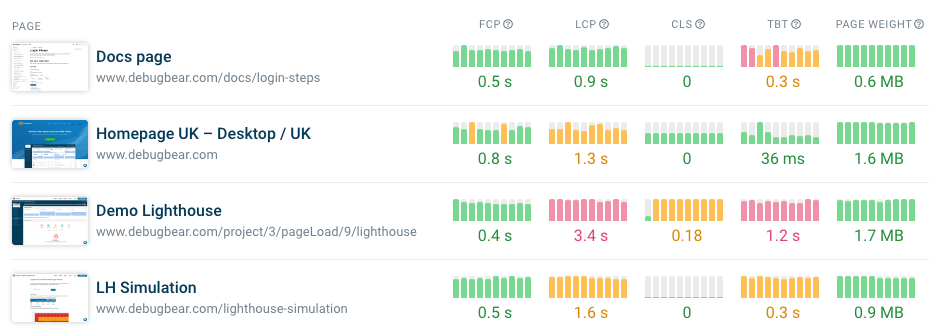 Screenshot exhibiting web site pace tendencies for a web site in DebugBear, October 2022
Screenshot exhibiting web site pace tendencies for a web site in DebugBear, October 2022window.addEventListener( 'load', function() { setTimeout(function(){ striggerEvent( 'load2' ); }, 2000); });
window.addEventListener( 'load2', function() {
if( sopp != 'yes' && addtl_consent != '1~' && !ss_u ){
!function(f,b,e,v,n,t,s) {if(f.fbq)return;n=f.fbq=function(){n.callMethod? n.callMethod.apply(n,arguments):n.queue.push(arguments)}; if(!f._fbq)f._fbq=n;n.push=n;n.loaded=!0;n.version='2.0'; n.queue=[];t=b.createElement(e);t.async=!0; t.src=v;s=b.getElementsByTagName(e)[0]; s.parentNode.insertBefore(t,s)}(window,document,'script', 'https://connect.facebook.net/en_US/fbevents.js');
if( typeof sopp !== "undefined" && sopp === 'yes' ){ fbq('dataProcessingOptions', ['LDU'], 1, 1000); }else{ fbq('dataProcessingOptions', []); }
fbq('init', '1321385257908563');
fbq('track', 'PageView');
fbq('trackSingle', '1321385257908563', 'ViewContent', { content_name: 'best-website-speed-tests-debugbear-spcs', content_category: 'seo sponsored-post technical-seo digital-marketing-tools' }); } });
from Link Building SP – My Blog https://ift.tt/ZbCzhmc
via IFTTT